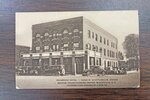




Many Blackville residents felt the Shamrock Hotel was either an eroding eyesore or a homage to history. The long-anticipated demolition of the former ‘handsome hotel' on October 25 left the town divided over what to do with its ruins.
“People have mixed emotions,” said Blackville Mayor Ronnie Pernell.
Town council accepted a $170,000 bid from LRB Site Prep & Hauling, LLC in October to demolish, remove, grate, lay and level new dirt. Mayor Pernell explained the terms of this bid gave the contractor until December 31 to accomplish this work.
“We do not set boundaries on the contractor on when they start or how long [it takes], as long as they meet that deadline,” said Mayor Pernell.
Blackville residents, and even some county and town officials, did not know the Shamrock Hotel was coming down until demolition equipment moved in and bricks began falling.
The date of demolition was not known by community members who had conversations with Mayor Pernell once the bid was placed about preserving the Shamrock Hotel, or even parts of it.
“We lost the history of it based on the way it looked and I think that it's disappointing that we allowed it to get to this point,” said Mayor Pernell. “Now we have the opportunity to rebuild something to try to preserve some of the history.”
Ideas like a walking path with historical markers displaying information about the building were pitched to the mayor. A major part of this concept was the preservation of the octagonal tile mosaic floor with ‘The Shamrock Hotel’ written across in a dark green.
Although efforts were made to arrange preservation tactics prior to demolition, miscommunication between town officials, the demolition team, and community members, alongside uncertainty when it would be taken down, led to no solid plan being in place to save pieces of the hotel.
Only one of the cement pots that sat atop columns along the building’s terrace was able to be preserved amidst the rubble of bricks and fragments of octagonal tiles. It currently sits at the Blackville Heritage Museum.
Mayor Pernell is open to ideas on how to save the history of the Shamrock, even post-demolition.
The Shamrock Hotel officially closed in 1967 and had been steadily decaying ever since. With its closure, and the societal switch from trains to cars, the town has been suffocated ever since.
The question of demolition or preservation has been in conversation since the 80s when the roof caved in early one Sunday morning. The People-Sentinel documented the collapse on the front page of that week’s newspaper.
When current Barnwell County Councilman David Kenner was the mayor of Blackville from 1999 to 2003, he recalled securing funds to reconstruct the building into something entirely new.
However, the push to restore the Shamrock back to a hotel was strong and the community rejected Kenner’s plan.
In 1995, The People-Sentinel reported the Shamrock Hotel was named one of the 11 most endangered historic sites in SC by the state department of Archives and History. The building was nominated to this list by former executive director of the Blackville Community Center, Charles Brooks.
The late Ray Miller, founder of Miller’s Bread Basket in Blackville, tried to organize its revival through his non-profit, Historical Business Ventures Inc. and secured $35,000 to build the trusses that later held the face of the building up for decades, according to an August 1997 article written by Pat Butler for The State.
Although Miller tried diligently to save the building, funding for the million dollar project could not be acquired to do so.
The recognizable face of the building was covered in four-leaf clover planted by Miller to pay homage to its Irish origin until its demolition.
Jack Farrell opened the Shamrock Hotel 110 years prior to “capitalize upon railroad travelers like traveling salesmen and produce buyers doing business in town,” according to a historical marker in Blackville.
Blackville was on the rail line from Charleston to Hamburg, and the establishment of the Shamrock Hotel turned the small town into a desirable destination.
The three-story building with 30 rooms each with their own bathroom was described as elegant and handsome, and served as a hub for certain members of the community. Epp’s Drug Store operated on the lower level and the hotel was in full-swing upstairs.
In 1958, Hugh W. Quattlebaum and his family bought the hotel. Hugh’s wife, Myrtle Quattlebaum, documented the history of the building in 2009.
“During its heyday, the lobby of the Shamrock was a gathering place for some of the locals as well as guests of the hotel. There were several tables for writing or playing games, and a pool table in the back of the lobby. A lively game of poker was often enjoyed after dinner in the convivial atmosphere. The built-in registration desk was near the front. The floor was of white ceramic tile with ‘The Shamrock’ spelled out in green tiles near the lobby entrance, and the ceiling was of white embossed metal. The front portion of the ground level contained two offices, the hotel main entrance, and a pharmacy on Main Street. There was an office on the Walker Street side which was occupied several times by beauty salons and finally an electronics shop. There was also a Walker Street entrance to the hotel,” wrote Quattlebaum.
After the Quattlebaums ownership, the building was bought by the Phoenix Preservation Group who owned it briefly in an attempt to restore it. However, it was ultimately sold to the Town of Blackville.
For some, memories of the Shamrock Hotel are shrouded in fizzy drinks from the marble soda fountains in Epps Drug Store. For others, the building resembled a time where society wasn’t as equal.
“That was the first time I experienced racism,” said Blackville resident and Blackville Community Development Corporation member Pearline Lee of her childhood memories of Epps Drug Store.
Lee explains in the early 1960s, less than a decade before the hotel closed, that Black residents would shop in town on the weekends while their kids would walk around the bustling town.
“We got a dime or something, so we just ran around to different stores, getting a little candy or stuff like that,” said Lee.
“I went down to Epps Drug Store as a kid, the little shiny bar stools ran in there and we were putting in our little orders for ice cream and stuff, and I got on the stool,” said Lee. “This man came from behind the counter and told me to, ‘get up and get out of that stool now, I'm gonna call the police on you.’”
“Oh, that traumatized me,” said Lee, who was eight or nine at the time and is about to turn 67.
Lee never told her parents, and spent a long time looking over her shoulder out of fear the police were coming to arrest her.
“I was just so scared the police officers were coming to get me,” said Lee. “I never went back in there.”
For Lee, seeing the Shamrock come down was like seeing the Confederate flag voted to be removed from the state capitol building in July 2015.
“We just didn't have the same place, the white kids could go in there with their friends and sit down, have milkshakes and sit around and enjoy,” said Lee. “We couldn't do that.”
“Most of the Black community, they didn't care too much for it,” said Mayor Pernell. “I wasn't brought up in that era that they were not allowed to stay there, but they remember they were allowed to go in, pick up an item, and get out. They couldn't sit down, they couldn't stay there. So, it is a mixed emotion.”
When the Shamrock Hotel closed in 1967, Blackville’s economy began to slowly turn downward too. Some hope with its demolition comes revitalization.
“Blackville has existed a long time and we should be a little further ahead than we are now,” said Lee.
The Shamrock Hotel is now a pile of bricks on Main Street. Its remnants hold memories of both joy and pain for Blackville residents, but regardless of sentiment many want to see a flourishing business rise where it once stood.